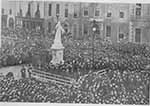Mary Redmond (1863–1930), sculptor, was born in Nenagh, Co Tipperary, daughter of a quarry worker, and moved at a young age with her family to Ardclough, where her father was employed in the limestone quarries.
The family resided in a small cottage alongside the quarry, where as a child she modelled small animals and figures from the malleable quarry clay.
At school in Ardclough she showed talent in modelling the soft clay from a sinkhole near her home into clay figures. One particularly life-like model of a ‘travelling woman’ attracted the attention of a neighbour, who encouraged the family to send their daughter to Dublin for tuition.
At just nine years of age (1872) Mary Redmond was sent to Dublin to live with friends and attend primary school. Thomas Farrell was persuaded to allow the young girl to work in his studio, where she made her first formal model, ‘a hand on a cushion’.
He suggested she attend the Dublin Metropolitan School of Art in Kildare St. Although considered too young by the headmaster, RE Lyne, she was accepted and received tuition in drawing and painting. However, she preferred to model with clay.
Her first exhibits in the Royal Hibernian Academy (1880) were portrait busts and medallions. She worked from studios in Nassau St. and Grafton St. (1885–6), provided rent-free by the jeweller Edmond Johnson, who also provided her with sitters. During this time she continued to exhibit in the RHA (bust of Albert B Leech, 1885) and pursued courses of study (1886/7) in Rome and in Florence. She returned to Dublin (1889) and was selected in an open competition to make the memorial for the controversial William Limbrick Martin for the Phoenix Park RIC depot (the bust was moved in 1967 to RUC headquarters, Belfast, and the remainder of the memorial is in St James church, Dublin). During this period she went to London, where she modeled a bust of WE Gladstone (now lost). Amongst her other works were a bust of Dwyer Grey (of which thirty repeats were made) and a presentation shield to Lord Wolseley.
In 1890 an open competition was held for a statue of Fr Luke Matthew the ‘apostle of temperance’, to be located in O’Connell St., Dublin. It attracted a large number of contestants and Redmond won, quite an achievement for a woman artist at the time.
Her most famous work was not completed without some unexpected difficulties. According to Nora J Murray’s article in Capuchin Annual (1932) the male model for the Father Mathew statue took the concept of getting plastered a little too far, and was dismissed. In revenge he returned at night and smashed the statue. Redmond began again and the monumental sculpture was unveiled before a huge crowd on 8 February 1893.
Mary Redmond married (1893) Dr W Dunn of Florence in London. The couple lived in Florence at Villa Alinari, near Galileo’s tower, where Irish visitors were always given a warm welcome. Redmond looked after his two children, a boy and a girl, and is known to have made two angels for the Church of the Little Company of Mary in Florence, but these cannot be located.
She died on 16 January 1930 in Florence, in the care of an Irish nun from the convent of the Little Company of Mary. Her daughter, Signora E Papascogli, presented (1953) to the National Gallery, Dublin, a replica of a marble bust her mother had sculpted in 1889 of Edmund Dwyer Grey.
References:
- Obituary Irish Times, 14 Feb. 1930,
- Nora J Murray, ‘Mary Redmond’, Capuchin Annual 1932, 84–7;
- Adrian le Harivel, Illustrated summary catalogues of prints and sculpture (1988), Snoddy


